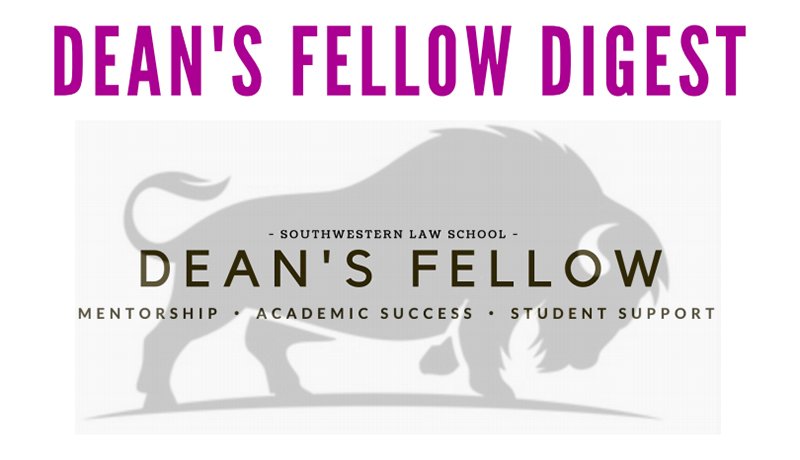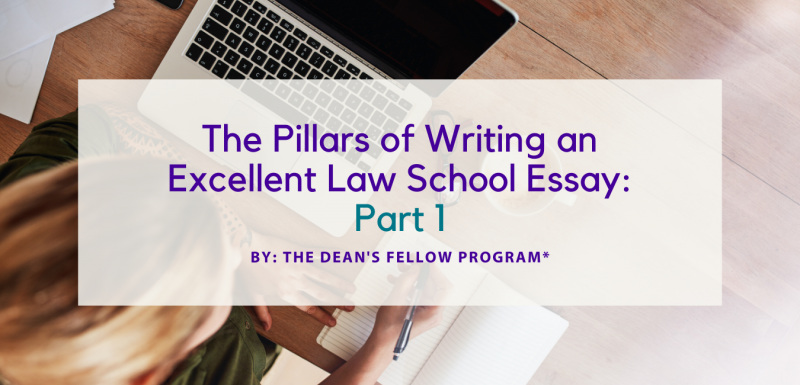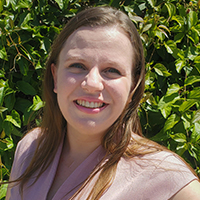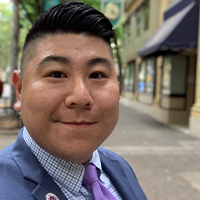SWLAW Blog | Dean's Fellow Digest

April 23, 2021
Dean's Fellow Digest Issue #28 - The Pillars of Writing an Excellent Law School Essay: Part I
Issue: 2021-4-23
Dean's Fellows consistently strive to support students in realizing their full academic potential, leading ultimately to success on the bar exam and in the workplace. To support all Southwestern students in this goal, the Dean's Fellows created this Digest as a way to check in at critical times throughout the semester with helpful tips, strategies, and encouragement.
IN THIS ISSUE:
- The Pillars of Writing an Excellent Law School Essay: Part I

(1) Responds precisely to the call of the question.
Common Error 1: Discussing issues that are outside the call of the question.
- The call of the question limits the writer to a homicide discussion, but the facts indicate that a robbery took place. When responding to the call of the question, it would be inappropriate to discuss the elements of robbery in-depth, but rather the robbery goes to a felony murder discussion, directly purporting to answer the call of the question.
Common Error 2: Failing to discuss a whole group of issues that are within the call of the question.
As discussed in Foundations, identify relationships that arise between legal issues. This is a particularly important part of outlining, as well. This also shows a full understanding of how different issues interrelate.
- In continuing with our homicide example above, an appropriate discussion of homicide must consider the connections and distinctions between malice aforethought, first and second-degree murder, voluntary manslaughter, and involuntary manslaughter, as well as the felony murder rule. "Homicide" is a multi-faceted topic with interrelated parts.
- Also, before you start writing, double-check the call of the question to ensure you are being responsive to what it asks. Timed conditions do not allow for a major reorganization at the end of an essay because you thought the call asked for something different. That is a major waste of valuable time you won’t be able to make up, so start with a draft outline of what you need to answer and how to organize that answer.
~ Haley Pollock
(2) Identifies and discusses all legal issues relevant to answering the question.
Common Error 1: Failing to discuss particular legal issues raised by the facts.
As discussed in Foundations, pay close attention to fact triggers when it comes to both legal issue spotting, as well as developing a complete analysis. Such fact triggers can be found in cases, hypos, practice essays, and multiple-choice questions.
- There are two important components to ensure you raise all—or most—of the issues on a final exam: Practice to increase your efficiency and comfort level with issue spotting and read carefully. Don’t rush when reading a fact pattern. One approach is to read the facts once to get a general idea of the story and then read it again to annotate and issue spot carefully.
~ Andy De la Cruz
Common Error 2: Discussing legal issues that are NOT raised by the facts.
This goes back to being responsive to the call of the question and being a problem solver. It is not good practice to “throw all the darts at the wall” by attempting to discuss every legal concept learned.
- The more practice you put in with exam writing, the better you will become at issue spotting. Another thing I do to practice issue-spotting is doing multiple choice questions on Themis Quiz Builder. This gives me more fact patterns to read and aids in fact pattern recognition.
- You should not just try to write everything you have learned. This is counterproductive because 1) this shows you have not learned how to properly issue spot, which is a big part of your understanding of the material; 2) you waste valuable time on the exam, which was designed with the exact issues to be addressed in mind; and 3) it will likely frustrate the grader, who would rather read a well thought out exam that is on point and without unnecessary information.
~ Nuccio Patti
(3) For each legal issue identified…
Organizes the discussion of the issue using the IRAC format.
Common Error: Beginning to discuss the facts relevant to the issue before stating and explaining the governing rule(s).
- IRAC is really important to follow for organizational purposes. You shouldn’t begin to discuss the facts in the fact pattern without first establishing why you’re discussing them. You should always first discuss the rule (R), and then follow with the applicable facts that relate to that rule (A). For example, if the call of the question has you analyzing felony murder, it would be confusing to the reader if you started listing facts without explaining what the elements of felony murder are, or how to satisfy them.
~ Chloe Graham
- It is helpful to have multiple colored pens or a system that works for you to mark off the important facts as you go. Also, don’t think that just because a fact was used in one area (to prove or disprove an element), it does not apply to a different element.
~ Haley Pollock
Correctly and completely states all the rules relevant to the issue.
Common Error: Leaving out elements of a rule or misstating the elements.
This is also an important function of the outline: To ensure you have solidified your understanding in terms of accuracy and completeness of the legal rules.
- Check the rule statements in your outline with your Professor or TA during office hours to make sure you have a complete rule. Don’t just check the elements with them, put together a grammatically correct sentence that you think encapsulates everything you need to say. During the exam work off of that rule statement and be methodical. If you have an overarching rule statement that has three elements, make sure you discuss each element in your analysis. If you get lost on where you are during the exam (which happens to all of us at some point), your rule statement will give you a roadmap of where to go. (Alexandra Christensen)
~ Alexandra Christensen
Where necessary, explains what particular elements or factors of the rule mean.
Common Error: Failing to explain the meaning of a vague element in a rule.
- This can be tricky at times, but perhaps can be illustrated with something you are familiar with: what does the element of extreme and outrageous conduct mean under a claim of intentional infliction of emotional distress? As the Third Restatement puts it, “beyond the bounds of human decency such that it would be regarded as intolerable in a civilized community.” But what does that mean? Here, rule explanations will help identify the legal landscape so the reader is clear on the rule to determine whether the conduct at issue satisfies the element (or not, depending on your position), based on your application of the rule to the facts. A good set of rule explanations will likely make it easier to understand the rule and, more importantly, likely make your reasoning more persuasive. But if the rule is not clear, then it may not be clear enough to support your argument and cost you valuable points, both in adequately stating and explaining the rule, and then again in your analysis.
~ Dean Matsuyama
Methodically applies each and every element/factor of the rule to the facts.
Common Error: Forgetting to discuss and apply one or more of the elements/factors that were included in the stated rule.
- While likely there will be components of the rule where satisfaction is more ambiguous given the facts, and other components that are clearly satisfied, don’t forget to address each component of the law within your essay response. This goes back to solving the legal problem: All elements must be addressed, or all factors in a balancing test weighed, but discerning where the facts are more ambiguous is an important analytical skill.
~ Chloe Graham
When discussing a particular element/factor, identifies all and only those particular facts that are relevant to whether the element/factor is satisfied.
Common Error 1: Not including any facts at all in the discussion of the element/factor and stating only a conclusion about whether the element/factor is satisfied.
- Your analysis is the most important part of your exam, and almost always where the most points can be scored. It is really important to stick to IRAC, and especially elaborate on the “A”. For example, if the call of the question is asking you to analyze homicide, you will list your rule/elements for homicide, and then use all the facts possible that relate to the specific element you’re analyzing. If you state the rule/elements and then jump to your “C” to state whether or not it is satisfied, you have done no analysis, and you will receive very few points. Remember, the facts are given to you for a reason, so try to use them as much as possible, always making sure they explain how your rule is either satisfied or not.
~ Chloe Graham
- This is the mistake that I have made on several occasions, witnessed by some of the feedback on my graded exams. The facts are in the pattern for a reason. It is paramount to organize your response before jumping into writing. For example, an analysis that covers whether something is an offer is supposed to cover facts that relate to the intent of the offeror when he made a certain statement, and whether his statement contains committal language and definite terms. An error would be to state that X’s statement constituted a valid offer because the facts indicate so. It is important to connect the dots between the elements/factors and the facts that support or negate an element, followed by a conclusion that logically flows from your analysis. We need a who, what, where, when, why, how in our analysis to present the full picture and score as many points as possible.
~ Elena Cordonean
Common Error 2: Identifying facts that are not relevant to the element/factor being analyzed.
This means that you did not understand prior to entering the exam how the facts interact with that particular legal rule, highlighting once again the importance of fact triggers.
… Stay tuned for Part II of this article on the Blog next week!
*About the Authors:
ELENA CORDONEAN
 Elena is a 2L evening student who holds two master’s degrees obtained in Europe before entering law school. At Southwestern, she intends to focus her academic coursework on criminal, international, and environmental law. She is fluent in five languages and is interested in building a strong educational background that would help her pursue a career at an intergovernmental organization. While attending Southwestern, Elena works as a law clerk for a personal injury law firm where she is involved in all aspects of the pre-litigation and litigation process.
Elena is a 2L evening student who holds two master’s degrees obtained in Europe before entering law school. At Southwestern, she intends to focus her academic coursework on criminal, international, and environmental law. She is fluent in five languages and is interested in building a strong educational background that would help her pursue a career at an intergovernmental organization. While attending Southwestern, Elena works as a law clerk for a personal injury law firm where she is involved in all aspects of the pre-litigation and litigation process.
Elena believes that the study of law, while providing a lifetime of opportunities, invaluable connections, and the ability to attain the highest degree of self-realization, is not without challenge. She is excited to help the incoming evening students to succeed because it is not about the individual but rather the collaboration of skills and experience that will ensure success and uphold the values that are true to all of us.
ALEXANDRA CHRISTENSEN
 Alexandra is a 3L evening student. She completed her B.A. in Liberal Arts with a concentration in Political Economy at The Evergreen State College. Originally from Montana, Alexandra moved to Los Angeles because she was tired of being cold. Over this past summer, she had the privilege of serving as a Judicial Extern with the United States Bankruptcy Court. Prior to her externship, she worked in higher education as the Operations Manager for a small college. She looks forward to working with incoming students and helping them adjust to law school life.
Alexandra is a 3L evening student. She completed her B.A. in Liberal Arts with a concentration in Political Economy at The Evergreen State College. Originally from Montana, Alexandra moved to Los Angeles because she was tired of being cold. Over this past summer, she had the privilege of serving as a Judicial Extern with the United States Bankruptcy Court. Prior to her externship, she worked in higher education as the Operations Manager for a small college. She looks forward to working with incoming students and helping them adjust to law school life.
When not working or in school, Alexandra likes to travel with her husband, watch movies, and play with her dog, a corgi-mix named Hudson. Hudson will likely make occasional appearances on Zoom calls because he is loud and likes attention.
ANDY DE LA CRUZ
 Andy is a Traditional Day 2L student in Southwestern’s Traditional Day Program. Andy graduated from UCLA in 2017 with a B.A. in Political Science. After graduating from UCLA, Andy worked for the non-profit organization Neighborhood Legal Services of Los Angeles County. As a paralegal at Neighborhood Legal Services, he helped low-income individuals and families in the areas of healthcare and housing law.
Andy is a Traditional Day 2L student in Southwestern’s Traditional Day Program. Andy graduated from UCLA in 2017 with a B.A. in Political Science. After graduating from UCLA, Andy worked for the non-profit organization Neighborhood Legal Services of Los Angeles County. As a paralegal at Neighborhood Legal Services, he helped low-income individuals and families in the areas of healthcare and housing law.
At Southwestern, Andy is also a Peer Mentor, the treasurer for the Latino Law Students Association (LLSA), the Westlaw Student Representative, and a staffer on the Southwestern Law Review. He also externed for Chief Judge Philip S. Gutierrez during his 1L summer through the Mexican American Bar Association’s Federal Judicial Externship Program. Andy hopes to pursue a summer position at a big law firm during his 2L summer. He is currently interested in the areas of intellectual property, entertainment, and sports law. Andy credits his success at Southwestern to his mentors, peers, and the wonderful staff and school community that provide him continued support.
When Andy isn’t studying or reading, he loves watching sports, collecting sneakers, and is a huge Lakers fan. Please do not hesitate to reach out with any questions for Andy or to schedule an appointment.
CHLOE GRAHAM
 Chloe is a Traditional Day 2L student who graduated from the University of California, Berkeley in 2018 with a B.A. in Political Science. Prior to attending Southwestern, Chloe worked as a Staff Assistant for the House of Representative both on Capitol Hill in Washington D.C., and in her hometown of Bakersfield, California. She spent her summer clerking at a medium-sized civil defense litigation firm where she was able to gain real-world experience working on both medical malpractice and employment law cases.
Chloe is a Traditional Day 2L student who graduated from the University of California, Berkeley in 2018 with a B.A. in Political Science. Prior to attending Southwestern, Chloe worked as a Staff Assistant for the House of Representative both on Capitol Hill in Washington D.C., and in her hometown of Bakersfield, California. She spent her summer clerking at a medium-sized civil defense litigation firm where she was able to gain real-world experience working on both medical malpractice and employment law cases.
Chloe is a member of the International Law Journal, a Teaching Assistant, and a part of the Children’s Rights Clinic. In 2019, she became one of the youngest certified Court Appointed Special Advocates in Kern County, and has a passion for child advocacy through adoption. She loves connecting with people and understands how difficult the transition to law school can be, so please reach out to her!
DEAN MATSUYAMA
 Dean is a 2L Evening student seeking to practice in public interest law. He holds undergraduate degrees in Political Science and Criminology from UC Irvine and an MPA from CSUN. For the last seven years, he has been a paralegal for the Children's Law Center of California which serves as court-appointed minor's counsel in juvenile dependency cases.
Dean is a 2L Evening student seeking to practice in public interest law. He holds undergraduate degrees in Political Science and Criminology from UC Irvine and an MPA from CSUN. For the last seven years, he has been a paralegal for the Children's Law Center of California which serves as court-appointed minor's counsel in juvenile dependency cases.
A Dean's Merit Scholar and CALI Award recipient, Dean hopes he can help you thrive at Southwestern so you can get the most out of your law school experience. He looks forward to serving the Southwestern community and cannot wait to see your success. Please contact him if you have any questions or concerns.
NUCCIO PATTI
 Nuccio is a 2L Evening student who graduated from U.C. Berkeley with a B.A. in Political Science in 2005, and from C.S.U. Northridge with an M.B.A. in 2011 and an M.A. in Urban & Regional Planning in 2018. Nuccio works as a nonprofit real estate developer building homeless and special needs housing. Recently, Nuccio joined the Moot Court Honors and Dean’s Fellow Programs.
Nuccio is a 2L Evening student who graduated from U.C. Berkeley with a B.A. in Political Science in 2005, and from C.S.U. Northridge with an M.B.A. in 2011 and an M.A. in Urban & Regional Planning in 2018. Nuccio works as a nonprofit real estate developer building homeless and special needs housing. Recently, Nuccio joined the Moot Court Honors and Dean’s Fellow Programs.
Nuccio is very excited to be a Dean’s Fellow and would love to chat with you about your law school experience. In his free time, Nuccio enjoys spending time with friends and family, reading, cooking, cycling, Formula 1, and learning on YouTube.
HALEY POLLOCK
 Haley Pollock is a Traditional Day 3L student with a concentration in public interest law. This summer, Haley worked as a judicial extern in the Hearings Unit at the Equal Employment Opportunity Commission. There, she conducted extensive legal research and wrote about employment discrimination violative of Title VII of the Civil Rights Act of 1964. Before attending law school, Haley was Chief Financial Officer to a trauma-informed drug rehabilitation center and Director of Operations for a post-production house.
Haley Pollock is a Traditional Day 3L student with a concentration in public interest law. This summer, Haley worked as a judicial extern in the Hearings Unit at the Equal Employment Opportunity Commission. There, she conducted extensive legal research and wrote about employment discrimination violative of Title VII of the Civil Rights Act of 1964. Before attending law school, Haley was Chief Financial Officer to a trauma-informed drug rehabilitation center and Director of Operations for a post-production house.
Haley sits on a regional council for NARAL where she promotes reproductive freedom policies by mobilizing support for priority bills by organizing phone banks, petition-signings, and letter-writing parties. She also serves as an elected committee member of the National Lawyers Guild Los Angeles Immigration Law Steering Committee She is a dedicated advocate of immigrant and workers’ rights, women and children’s rights, affordable housing, and other policy issues affecting residents of Los Angeles. Last year, Haley was a member of the law review and moot court honors programs. This year, she is the co-vice chair of National Lawyers Guild student association, the pro bono coordinator for the Homelessness Law Prevent Project, a senior writing fellow, and a returning Dean’s fellow. She looks forward to helping incoming students succeed in their studies.
Southwestern Law School Dean's Fellows | Scheduling and Booking Website
Dean’s Fellows are upper-division students with strong academic skills who go through a rigorous application and training process. They are an integral part of the Academic Success and Bar Preparation Department. They are carefully selected based on their academic excellence and ability to teach other students best-practice study methods that will help them become acclimated to the study of law. Dean’s Fellows meet with students as academic mentors.
Please click HERE to make an appointment with a Dean's Fellow.